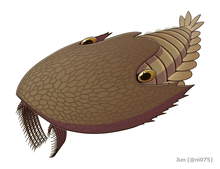寒武耙蝦屬
| 鐮刺寒武耙蝦 | |
|---|---|

| |
| 鐮刺寒武耙蝦的復原圖。 | |

| |
| 鐮刺寒武耙蝦的骨片化石照片。 | |
| 科學分類 | |
| 界: | 動物界 Animalia |
| 門: | 節肢動物門 Arthropoda |
| 綱: | †恐蝦綱 Dinocaridida |
| 目: | †放射齒目 Radiodonta |
| 科: | †赫德蝦科 Hurdiidae |
| 屬: | †寒武耙蝦屬 Cambroraster Moysiuk & Caron, 2019[2] |
| 種: | †鐮刺寒武耙蝦 C. falcatus
|
| 二名法 | |
| †Cambroraster falcatus Moysiuk & Caron, 2019[2]
| |
| 其他物種[3][4] | |
| |
鐮刺寒武耙蝦(學名:Cambroraster falcatus)是寒武耙蝦屬(學名:Cambroraster )的唯一一個物種,同時也是模式種,屬於赫德蝦科。[2]許多的地方都有發現此物種的化石,例如加拿大、中國、美國。[1][3]鐮刺寒武耙蝦的頭部骨片是馬蹄形狀的,還有一對長得像耙子的附肢。最初是由Moysiuk和Caron於2019年發表的。[2]鐮刺寒武耙蝦、線紋心蝦(Cordaticaris striatus)[5]和蓋氏巨盔蝦(Titanokorys gainesi)[6],有著非常類似形態且可能有親戚關係。[7]此物種是底棲(nektobenthic)物種,可能通過過濾海底泥沙中的小生物為食。[2][8]
命名
[編輯]鐮刺寒武耙蝦的學名-Cambroraster,是以Cambro是寒武紀(Cambrian)的意思,和raster是耙子,形容鐮刺寒武耙蝦前附肢上耙狀的附肢內葉,種加詞-falcatus意為鐮刀,描述顯爪蝦的頭部骨片類似鐮刀。這個名字也涉及到牠的綽號"千年隼"(spaceship),牠的頭部骨片類似於星際大戰的千年隼號(Millennium Falcon)。[2][9][註 1]
發現
[編輯]目前在加拿大西北英屬哥倫比亞的布爾吉斯頁岩(Burgess Shale)上面部分"史蒂芬組"(『Thick』 Stephen )[10]、大理石峽谷 (不列顛哥倫比亞)(Marble Canyon)[11]、都昆溪(Tokumm Creek)[12]和史蒂芬山(Mount Stephen)[10]發現了約140多個化石標本,共有ROMIP 65078、ROMIP 65079、 ROMIP 65080、ROMIP 65081、ROMIP 65082、ROMIP 65083、ROMIP 65084、 ROMIP 65085、ROMIP 65086、ROMIP 65087、ROMIP 65092、ROMIP 65093等。[2]中國北部山東省(約黃河至遼東的地區)的濰坊市(Weifang)發現了三個標本NIGPAS 171703、NIGPAS 171704、NIGPAS 171705,[4]昆明的澄江生物群只發現了YKLP 11420這個標本。[3]美國猶他州中部車輪頁岩(Wheeler Shale)的馬朱姆地層(Marjum Formation),也有發現。
一開始發現時,約瑟夫·莫伊休克(Joseph Moysiuk)將其稱作「這是一種長相非常奇特的動物」。[9]
形態
[編輯]-
He-C是鐮刺寒武耙蝦的頭部骨片,Fa-C是附肢化石。
-
A、B和C都是鐮刺寒武耙蝦的頭部骨片化石。
-
鐮刺寒武耙蝦的整體附原圖。
-
鐮刺寒武耙蝦的頭部是由1塊頭部骨片和2塊側邊骨片,眼睛位於骨片凹進去的部分,還有一對附肢和一個口錐 。[註 2]
骨片與眼睛
[編輯]眼睛的是細長的橢圓形,位於頭部骨片的凹口地方,稱作眼凹口(eye notches),比起赫德蝦和帕凡特蝦演凹口還要大上許多。[13][2]
目前發現過最大的頭部骨片(H骨片)標本,寬可達到18公分,身體的總長度為30公分。頭部骨片前半段是圓的;後半段的兩側到後面延伸成一對大刺的部分稱作側後刺突(posterolateral processes),側後刺突的兩側邊緣都會有小刺,小刺越往後逐漸變大,越往前逐漸變小;側後刺突上的小刺,外側的小刺約有比較明顯九個的小刺,而內側約有三個比較明顯的小刺;中間兩個半圓形的突出部分有一個"V"的形狀,這個部分稱作中凹口(medial notches)或稱作中雙葉突(bilobate posterior region)且側邊區域有稍微下陷。。通常側後刺突的長度不會越過中凹口。[註 3]在加拿大發現的許多頭部骨片都有很奇怪的彎曲,可能是因地層壓縮而扭曲變形,或者是因為頭部骨片很柔韌。[2]鐮刺寒武耙蝦的頭部骨片可能像鄭和蝦屬(Zhenghecaris[14])。[15][2]
側邊骨片(P骨片)的前面是細長、彎曲的部分稱作前頸(又稱P骨片頸)(P-elements neck[2],anterior neck section[2],beak[16]),後面是是類似比較膨脹的扁豆形狀組合而成的。在扁豆形狀的中間又更加的凸出,而且並沒有頭部骨片的眼凹口。雖然Moysiuk和Caron沒發現到頭部骨片與側邊骨片相連的化石,但是由於發現側邊骨片和頭部骨片都是在附近發現的,所以頭部骨片和側邊骨片有連接起來。[2]側邊骨片可能覆蓋住了鐮刺寒武耙蝦腹側的表面,類似於同科的赫德蝦屬(Hurdia)皮托蝦屬(Peytoia)。[2][16][17]
附肢
[編輯]附肢可能位在頭部更前面的下方。附肢共有10個節,其中最後的4個節稱作後端節(terminal element)。第一節是最大的,其中缺少像是第二節的前附肢棘(endite),在邊緣上還有一個凹陷的口。 中間的五個節比較結實,而且具有細長的前附肢棘。細長的前附肢棘的長度幾乎相同,大約是節高度的兩倍。每一個前附肢棘都有像一撮梳子狀的前附肢輔棘,裡面大概有20至25個非常細的前附肢輔棘,在前附肢輔棘的末端有稍微的捲曲,看起來的像鉤子。附肢的末端逐漸彎曲,是由最後四個非常短的節所組成的。倒數的三個節都有比較小的內刺(enditic spines),特別是倒數第二節和三節有比較大的刺。[2]
口錐
[編輯]
鐮刺寒武耙蝦擁有一個巨大的口錐(oral cone,是放射齒目的口器),口錐的形狀是稍微彎曲的四放射狀,是由相鄰的齒板(smooth plate)組成,其中四個大齒板被七個小齒板隔開來。這些齒板的口腔邊緣具有多達三個三角形的牙齒,這些牙齒在大板上非常堅固。口錐內有至少會有三排四放射狀排列的齒板,這些齒板向口錐的中心匯聚再一起。[2]
身體
[編輯]身體外觀看起來三角形,並具有八對游動葉(flap[18]),且身上有一條暗黑色的條紋,稱作剛毛板(setal blades[18]、lamellae[2],是由細長的毛附蓋在背側,排列成類似鰓的結構。[18])。[2][19]扇鰭越往前面越大,幾乎與頭部骨片差度多寬,大約佔身體長度的五分之一;到後面逐漸變小。在身體的末端有一個小尾扇(tail fan,類似魚的尾鰭。[20][21])可能是由兩對細長平行的向後橢圓形葉片組成的。[2]
生態
[編輯]鐮刺寒武耙蝦依據身體型態,例如:有著巨大的甲殼和頭、眼睛在背側、還有短小的身體,與鱟、螃蟹、甲冑魚非常相似,屬於生活在海底的特徵。鐮刺寒武耙蝦與底棲動物可能有的密切關係,也可能符合底棲動物的覓食生態學。
食性
[編輯]鐮刺寒武耙蝦的附肢不適合捕食其他動物,因為平行的鉤狀的前附肢輔棘會幹擾在相鄰前附肢棘之間抓住獵物。而附肢的型態也無法捕獲並攝取懸浮在水中的食物顆粒,透過鐮刺寒武耙蝦的前附肢輔棘的間距,大約只能捕捉到2毫米的顆粒,雖然會比赫德蝦屬抓到的還要小,但是比以懸浮在水中顆粒為食的甲殼動物大小還要大。此外,懸浮在水中顆粒為食的甲殼動物往往都會具有帶有鋸齒的剛毛,增加捕獲的顆粒,這與鐮刺寒武耙蝦中存在的堅固的前附肢輔棘有差異。[2]
註記
[編輯]- ^ 之後的2021年Moysiuk和Caron發現好幾個比較大的連到顯爪蝦的化石,後來證明是巨盔蝦屬的化石。
- ^ A: 背面 (Dorsal view) ,B: 腹面 (Ventral view) ,Ey: 眼睛(Eye) ,Fa: 附肢(Frontal appendages) ,He: 頭部骨片(H-element,H骨片) ,Bp:中凹口(Bilobate posterior region、Medial notches,中雙葉突) ,Lp:側後刺突(Posterolateral processes) ,Oc:口錐(Oral cone) ,Pe: 側邊骨片(P-element,P骨片) ,Pn:前頸(P-elements neck)
- ^ 有一個例外,Moysiuk和Caron發現一個年幼的骨片化石標本的側後刺突越過中凹口,可能是存在變異。
參考資料
[編輯]- ^ 1.0 1.1 Wu, Yu; Pates, Stephen; Ma, Jiaxin; Lin, Weiliang; Wu, Yuheng; Zhang, Xingliang; Fu, Dongjing. Addressing the Chengjiang conundrum: A palaeoecological view on the rarity of hurdiid radiodonts in this most diverse early Cambrian Lagerstätte. Geoscience Frontiers. 2022-11, 13 (6). ISSN 1674-9871. doi:10.1016/j.gsf.2022.101430.
- ^ 2.00 2.01 2.02 2.03 2.04 2.05 2.06 2.07 2.08 2.09 2.10 2.11 2.12 2.13 2.14 2.15 2.16 2.17 2.18 2.19 Moysiuk, J.; Caron, J.-B. A new hurdiid radiodont from the Burgess Shale evinces the exploitation of Cambrian infaunal food sources. Proceedings of the Royal Society B: Biological Sciences. 2019-07-31, 286 (1908). ISSN 0962-8452. doi:10.1098/rspb.2019.1079.
- ^ 3.0 3.1 3.2 Liu, Yu; Lerosey-Aubril, Rudy; Audo, Denis; Zhai, Dayou; Mai, Huijuan; Ortega-Hernández, Javier. Occurrence of the eudemersal radiodontCambrorasterin the early Cambrian Chengjiang Lagerstätte and the diversity of hurdiid ecomorphotypes. Geological Magazine. 2020-03-27, 157 (7). ISSN 0016-7568. doi:10.1017/s0016756820000187.
- ^ 4.0 4.1 Sun, Zhixin; Zeng, Han; Zhao, Fangchen. Occurrence of the hurdiid radiodontCambrorasterin the middle Cambrian (Wuliuan) Mantou Formation of North China. Journal of Paleontology. 2020-05-07, 94 (5). ISSN 0022-3360. doi:10.1017/jpa.2020.21.
- ^ Sun, Zhixin; Zeng, Han; Zhao, Fangchen. A new middle Cambrian radiodont from North China: Implications for morphological disparity and spatial distribution of hurdiids. Palaeogeography, Palaeoclimatology, Palaeoecology. 2020-11, 558. ISSN 0031-0182. doi:10.1016/j.palaeo.2020.109947.
- ^ Caron, J.-B.; Moysiuk, J. A giant nektobenthic radiodont from the Burgess Shale and the significance of hurdiid carapace diversity. Royal Society Open Science. 2021-09, 8 (9). ISSN 2054-5703. doi:10.1098/rsos.210664.
- ^ Moysiuk, Joseph; Caron, Jean-Bernard. A three-eyed radiodont with fossilized neuroanatomy informs the origin of the arthropod head and segmentation. Current Biology. 2022-08, 32 (15). ISSN 0960-9822. doi:10.1016/j.cub.2022.06.027.
- ^ Caron, J.-B.; Moysiuk, J. A giant nektobenthic radiodont from the Burgess Shale and the significance of hurdiid carapace diversity. Royal Society Open Science. 2021-09, 8 (9). ISSN 2054-5703. doi:10.1098/rsos.210664.
- ^ 9.0 9.1 Sokol, Joshua. Fossils show large predator prowled Cambrian sediments. Science. 2019-08-02, 365 (6452). ISSN 0036-8075. doi:10.1126/science.365.6452.417.
- ^ 10.0 10.1 Fletcher, Terence P; Collins, Desmond H. The Middle Cambrian Burgess Shale and its relationship to the Stephen Formation in the southern Canadian Rocky Mountains. Canadian Journal of Earth Sciences. 1998-04-01, 35 (4). ISSN 0008-4077. doi:10.1139/e97-120.
- ^ Caron, Jean-Bernard; Gaines, Robert R.; Aria, Cédric; Mángano, M. Gabriela; Streng, Michael. A new phyllopod bed-like assemblage from the Burgess Shale of the Canadian Rockies. Nature Communications. 2014-02-11, 5 (1). ISSN 2041-1723. doi:10.1038/ncomms4210.
- ^ Mayers, Benjamin; Aria, Cédric; Caron, Jean‐Bernard. Three new naraoiid species from the Burgess Shale, with a morphometric and phylogenetic reinvestigation of Naraoiidae. Palaeontology. 2018-07-10, 62 (1). ISSN 0031-0239. doi:10.1111/pala.12383.
- ^ Lerosey-Aubril, Rudy; Pates, Stephen. New suspension-feeding radiodont suggests evolution of microplanktivory in Cambrian macronekton. Nature Communications. 2018-09-14, 9 (1) [2024-01-22]. ISSN 2041-1723. doi:10.1038/s41467-018-06229-7. (原始內容存檔於2021-10-07).
- ^ Briggs, Derek E. G.; Fortey, Richard A. The Early Cambrian Radiation of Arthropods. Topics in Geobiology. Boston, MA: Springer US. 1992: 335–373. ISBN 978-1-4899-2429-2.
- ^ Zeng, Han; Zhao, Fangchen; Yin, Zongjun; Zhu, Maoyan. Morphology of diverse radiodontan head sclerites from the early Cambrian Chengjiang Lagerstätte, south-west China. Journal of Systematic Palaeontology. 2017-01-04, 16 (1). ISSN 1477-2019. doi:10.1080/14772019.2016.1263685.
- ^ 16.0 16.1 Daley, Allison C.; Budd, Graham E.; Caron, Jean-Bernard. Morphology and systematics of the anomalocaridid arthropodHurdiafrom the Middle Cambrian of British Columbia and Utah. Journal of Systematic Palaeontology. 2013-03-22, 11 (7). ISSN 1477-2019. doi:10.1080/14772019.2012.732723.
- ^ De Vivo, Giacinto; Lautenschlager, Stephan; Vinther, Jakob. Three-dimensional modelling, disparity and ecology of the first Cambrian apex predators. Proceedings of the Royal Society B: Biological Sciences. 2021-07-21, 288 (1955). ISSN 0962-8452. doi:10.1098/rspb.2021.1176.
- ^ 18.0 18.1 18.2 Van Roy, Peter; Daley, Allison C.; Briggs, Derek E. G. Anomalocaridid trunk limb homology revealed by a giant filter-feeder with paired flaps. Nature. 2015-03-11, 522 (7554). ISSN 0028-0836. doi:10.1038/nature14256.
- ^ Daley, C; Budd, E; Caron, C; Edgecombe, D; Collins, C. The Burgess Shale anomalocaridid Hurdia and its significance for early euarthropod evolution (project). MorphoBank datasets. 2014 [2024-01-22].
- ^ Chen, Jun-yuan; Ramsköld, Lars; Zhou, Gui-qing. Evidence for Monophyly and Arthropod Affinity of Cambrian Giant Predators. Science. 1994-05-27, 264 (5163). ISSN 0036-8075. doi:10.1126/science.264.5163.1304.
- ^ Daley, Allison C.; Edgecombe, Gregory D. Morphology of Anomalocaris canadensis from the Burgess Shale. Journal of Paleontology. 2014-01, 88 (1). ISSN 0022-3360. doi:10.1666/13-067.




![鐮刺寒武耙蝦的頭部是由1塊頭部骨片和2塊側邊骨片,眼睛位於骨片凹進去的部分,還有一對附肢和一個口錐 。[註 2]](http://upload.wikimedia.org/wikipedia/commons/thumb/9/9f/20200410_Radiodonta_Cambroraster_falcatus_head.png/431px-20200410_Radiodonta_Cambroraster_falcatus_head.png)






